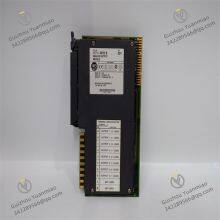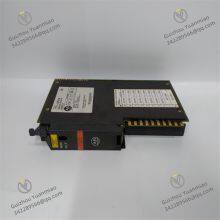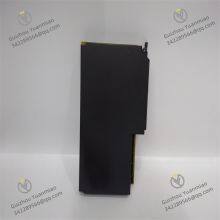I. Product Overview
Allen-Bradley 1771-OFE2 is a powerful analog output module in the 1771 series, dedicated to providing high-precision analog output control for industrial automation systems. In the process of modern industrial production, many links require precise control of equipment, such as the precise control of flow and pressure in chemical production, and the stable regulation of voltage and current in power systems. The 1771-OFE2 module can perfectly adapt to these scenarios. It can accurately convert the digital signals output by the PLC controller into 4-20mA DC current analog output signals, thereby providing stable and accurate control signals for various actuators (such as control valves, frequency converters, etc.), strongly ensuring the stable and efficient operation of industrial production processes.
In terms of structural design, the 1771-OFE2 module adopts a compact and standardized shape, which seamlessly adapts to the 1771 series I/O enclosures. This design allows it to be conveniently installed inside industrial control cabinets of various specifications, greatly saving valuable installation space. The module shell is made of high-quality industrial-grade plastic material, which has undergone strict environmental adaptability tests and has excellent anti-vibration and anti-impact performance. In environments with continuous vibration such as machinery manufacturing workshops and automated assembly lines, the module can still work stably, ensuring the accuracy and stability of signal output. At the same time, the shell also has good dust-proof and moisture-proof capabilities, which can effectively cope with the complex working conditions of dust and humidity in industrial sites, ensuring that the module can perform analog output control tasks reliably for a long time.

II. Performance Parameters
(1) Electrical Characteristics
Power Requirement: The working power of this module is taken from the backplane of the 1771 I/O enclosure, usually requiring 5V DC power supply, with a typical current consumption of about 1.4A (may fluctuate slightly under different working conditions). This power supply method realizes power sharing with other modules in the enclosure, eliminating the need for additional independent power supplies. It not only simplifies the system power supply design and reduces the overall cost but also significantly improves the stability and reliability of power supply.
Number of Output Points: The 1771-OFE2 module is equipped with 4 analog output channels, which can simultaneously perform precise analog control on 4 external devices, meeting the needs of small and medium-sized industrial control systems for analog output control of multiple devices. If more devices need to be controlled in practical applications, users can achieve flexible expansion by increasing the number of modules.
Output Signal Type and Range: The module supports DC current output signals, and the output current range is precisely set at 4-20mA. This standard current output range has wide applicability and can be well compatible with many actuators, sensors, and other equipment in industrial sites, ensuring the accuracy and stability of signal transmission. Whether driving control valves to adjust flow or controlling frequency converters to adjust motor speed, the 1771-OFE2 module can accurately match equipment requirements and provide stable and reliable control signals.
Output Resolution: The module has a high resolution of 12-bit binary, enabling fine adjustment of the output signal. In practical applications, high resolution means more precise control of analog quantities, which can effectively reduce control errors and improve the control accuracy and stability of the system. For example, in chemical production processes with high requirements for parameters such as flow and pressure, the high-resolution output of the 1771-OFE2 module can ensure precise control of the production process and guarantee the stability of product quality.
Signal Delay: In terms of signal response speed, this module performs excellently. The typical AC signal turn-off delay time is 45 (±15) ms, and the DC signal turn-off delay time is 50ms. It can quickly respond to changes in the PLC controller's instructions, adjust the output signal in a timely manner, ensure that external equipment can perform corresponding actions quickly and accurately, and meet the requirements for fast equipment response in industrial production.
(2) Interface Characteristics
External Load Interface: The 1771-OFE2 module is equipped with a standard terminal block for connecting external load devices. The terminal block adopts a screw fixing method, which is firm and reliable, and can effectively prevent loose wiring caused by external factors such as vibration and collision, ensuring the stability and reliability of signal transmission. The interface marks are clear and distinct, with the terminals of each output channel and the common terminal clearly distinguished, facilitating technicians to complete the wiring operation quickly and accurately, reducing the probability of wiring errors, and improving installation and commissioning efficiency.
Backplane Communication Interface: Through the backplane connector of the 1771 I/O enclosure, the module realizes high-speed and stable communication connection with the PLC processor. The backplane interface adopts an advanced electrical connection design, which can ensure that the control instructions sent by the PLC controller are transmitted to the module in a timely and accurate manner. At the same time, the module feeds back the processed analog output signal to the system, achieving efficient information interaction. This reliable communication connection enables the module to quickly respond to the control requirements of the PLC, ensuring the coordinated operation of the entire industrial automation system.
(3) Environmental Adaptability
Operating Temperature: The module can work stably in the temperature range of 0°C to 60°C, which covers the common temperature variation range in industrial production workshops. Whether it is a steel smelting workshop in a high-temperature environment in summer or a cold storage and logistics workshop in a low-temperature environment in winter, the 1771-OFE2 module can operate normally, unaffected by temperature fluctuations, continuously providing precise analog output control for equipment, and ensuring the continuity and stability of industrial production.
Storage Temperature: In the storage state, the module can withstand extreme temperature conditions from -40°C to 85°C. This feature ensures that the internal electronic components of the module will not be damaged even in harsh temperature environments during transportation, long-term storage, etc., thus ensuring the performance reliability of the module when put into use and reducing the risk of product damage caused by the storage environment.
Anti-Electromagnetic Interference: The 1771-OFE2 module strictly complies with industrial-grade electromagnetic compatibility standards and has strong anti-electromagnetic interference capabilities. In industrial sites, equipment such as motors, transformers, and electric welders generate strong electromagnetic interference during operation, and this module can effectively resist these interferences, prevent the output signal from fluctuating or malfunctioning due to interference, and ensure the accuracy of control over external equipment. In places with complex electromagnetic environments such as electronic manufacturing workshops, the module can work stably, providing reliable analog control signals for automated production equipment.

III. Functional Characteristics
(1) High-Precision Analog Output Control
The core function of the 1771-OFE2 module is to accurately convert the digital signals sent by the PLC controller into analog output signals, realizing high-precision control of external equipment. After receiving the control instructions sent by the PLC, the digital-to-analog conversion circuit inside the module works quickly to convert the digital signals into corresponding 4-20mA current signals for output. Whether it is precise adjustment of continuously changing physical quantities such as flow and pressure, or stable control of equipment operating parameters such as motor speed and valve opening, the module can rely on its excellent conversion accuracy and stable output performance to ensure the accuracy and reliability of the control process. For example, in an automated filling production line, precise control of the opening of the filling valve through the 1771-OFE2 module can achieve precise control of the liquid filling volume, effectively improving product quality and production efficiency.
(2) Channel Isolation Function
The 4 output channels of the module all adopt independent electrical isolation design, with each channel isolated from each other, and the isolation voltage is as high as 1000V. This isolation design can effectively prevent signal interference between channels and avoid the impact of a fault in one channel on the normal operation of other channels. In complex industrial electromagnetic environments, the channel isolation function can ensure that the signal transmission of each output channel is not affected by other channels and external interference sources, ensuring the purity and stability of the output signal, and improving the overall reliability and anti-interference ability of the system. For example, in the chemical production process, different process links may require different control signals, and the channel isolation function of the 1771-OFE2 module can ensure that the control signals of each link do not interfere with each other, ensuring the safety and stability of the production process.
(3) Fault Self-Diagnosis and Indication Function
This module has perfect fault self-diagnosis capability. Every time it starts, the detection circuit inside the module will automatically conduct a comprehensive inspection of each functional module. Once a fault is found, it will immediately indicate through the fault indicator light on the panel. For example, when a short circuit, open circuit, or other faults occur in an output channel, the corresponding fault indicator light will light up, and at the same time, the module will feed back the fault information to the PLC controller, so that technicians can carry out fault troubleshooting and repair in a timely manner. This fault self-diagnosis and indication function greatly shortens the system fault troubleshooting time, improves the maintenance efficiency of the equipment, reduces the production downtime caused by equipment faults, and lowers the production losses of the enterprise.
(4) Good Compatibility and Expandability
The 1771-OFE2 module has excellent compatibility with Allen-Bradley PLC-5 series controllers and other mainstream brands of PLC systems, and can be directly connected to the PLC control system without complex configuration and debugging processes. At the same time, it supports mixed installation with other types of modules (such as digital input/output modules, analog input modules, etc.) in the 1771 I/O enclosure, facilitating users to build a complete and flexible industrial automation control system according to actual needs. When the enterprise's production scale expands or the process requirements change, users can easily expand the analog output control capability of the system by simply increasing the number of 1771-OFE2 modules, meeting the growing production needs and providing strong support for the sustainable development of the enterprise.

IV. Installation Steps
(1) Preparation Before Installation
Carefully check whether the appearance of the module has abnormalities such as damage and deformation, and ensure that the module shell and all components are intact. At the same time, check whether key components such as the terminal block are firm and free from looseness.
Confirm that the installation environment meets the working requirements of the module, and it should be away from strong electromagnetic interference sources, high-temperature heat sources, and corrosive substances. Choose a well-ventilated, dry, and clean installation location to ensure that the module works under normal environmental conditions.
Prepare necessary installation tools, such as screwdrivers, wire strippers, multimeters, etc. Use a multimeter to measure the power supply voltage of the chassis backplane to ensure that it meets the power requirements of the module (5V DC).
Before installation, be sure to disconnect the power supply of the 1771 I/O enclosure to ensure the safety of the installation process and prevent electric shock accidents and module damage.
(2) Module Installation
Align the 1771-OFE2 module with the empty slot of the 1771 I/O enclosure, push it in smoothly and slowly along the guide rail until the module is in close and accurate contact with the enclosure backplane connector. During the pushing process, pay attention to keeping the module horizontal and vertical to avoid damage to the connector or poor contact due to inclination.
Use the matching screws to firmly fix the module on the enclosure. When tightening the screws, pay attention to uniform force to ensure that the module will not loosen due to vibration during equipment operation, which will affect the stability of the electrical connection. It is generally recommended that the screw tightening torque be controlled at 7-9 inch-pounds to ensure the fixing effect.
(3) External Wiring
According to the system electrical schematic diagram, connect the connecting wires of external load devices to the terminal block of the module one by one. When wiring, strictly distinguish the terminals of each output channel and the common terminal, connect them accurately according to the terminal marks, ensure that the wiring is firm and reliable, and avoid problems such as virtual connection and short circuit.
Select appropriate specifications of wires. It is recommended to use 12-gauge stranded or solid wires with an insulation thickness of 3/64 inches (about 1.2mm), such as Belden 8761 cables. This specification of wire can meet the requirements of the module's output current, and at the same time has good electrical performance and mechanical strength, ensuring the stability of signal transmission.
When connecting the wires, pay attention to the correct connection of the positive and negative poles of the DC power supply to avoid damage to the load equipment or the module due to reverse connection. After wiring is completed, check again whether each wiring point is firm and whether the wires are damaged or squeezed.














































